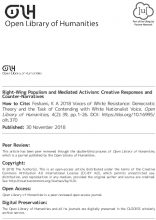This article is concerned with the distinction between acceptable race talk in social media and organised, extreme or ‘frozen’ racism which is considered hate speech and removed. While in the literature this distinction is used to point to different variants, styles and mutations of racism, in social media platforms and in European regulatory frameworks it becomes policy. The empirical part of the article considers this distinction drawing upon a series of posts following a stabbing incident in a small Irish town, which organised Twitter accounts sought to connect to terrorism. The empirical analysis examines the tweets of those accounts and the comments left on the Facebook page and website of one of the main Irish online news outlets. The analysis shows few if any differences between the two, concluding that there is a blending of supremacist and everyday, ambient racist discourses. This blending indicates the operation of a transnational contagion, given the shared vocabularies and discourses. It further problematises the distinction between ‘illegal hate speech’ and ‘acceptable race talk’, and throws into question the principle underlying both the policies of social media as well as the European efforts to de-toxify the digital public sphere.
